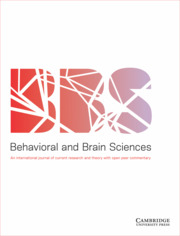No CrossRef data available.
Article contents
The unboxing has already begun: One motivation construct at a time
Published online by Cambridge University Press: 31 January 2025
Abstract
Murayama and Jach argue that it is not clearly specified how motivation constructs produce behavior and that this black box should be unpacked. We argue that the authors overlook important classic theory and highlight recent research programs that already started unboxing. We feel that without relying on the mechanisms that such programs uncover, the proposed computational approach will be fruitless.
- Type
- Open Peer Commentary
- Information
- Copyright
- Copyright © The Author(s), 2025. Published by Cambridge University Press
References
Bakbani-Elkayam, S., Dolev-Amit, T., Hemed, E., Zilcha-Mano, S., & Eitam, B. (2024). Intact modulation of response vigor in major depressive disorder. Motivation and Emotion, 48(2), 209–221. https://doi.org/10.1007/s11031-024-10059-0CrossRefGoogle Scholar
Berridge, K. C., & Robinson, T. E. (1998). What is the role of dopamine in reward: Hedonic impact, reward learning, or incentive salience? Brain Research Reviews, 28(3), 309–369. https://doi.org/10.1016/S0165-0173(98)00019-8CrossRefGoogle ScholarPubMed
Bindra, D. (1974). A motivational view of learning, performance, and behavior modification. Psychological Review, 81(3), 199–213. https://doi.org/10.1037/h0036330CrossRefGoogle ScholarPubMed
Bolles, R. C. (1972). Reinforcement, expectancy, and learning. Psychological Review, 79(5), 394–409. https://doi.org/10.1037/h0033120CrossRefGoogle Scholar
Custers, R., & Aarts, H. (2005). Positive affect as implicit motivator: On the nonconscious operation of behavioral goals. Journal of Personality and Social Psychology, 89(2), 129–142. https://doi.org/10.1037/0022-3514.89.2.129CrossRefGoogle ScholarPubMed
Custers, R., & Aarts, H. (2010). The unconscious will: How the pursuit of goals operates outside of conscious awareness. Science, 329(5987), 47–50. https://doi.org/10.1126/science.1188595CrossRefGoogle ScholarPubMed
Eitam, B., & Higgins, E. T. (2014). What's in a goal? The role of motivational relevance in cognition and action. Behavioral and Brain Sciences, 37(2), 141–142. https://doi.org/10.1017/S0140525X13002008CrossRefGoogle Scholar
Eitam, B., Kennedy, P. M., & Higgins, E. T. (2013). Motivation from control. Experimental Brain Research, 229, 475–484. https://doi.org/10.1007/s00221-012-3370-7CrossRefGoogle ScholarPubMed
Förster, J., Higgins, E. T., & Bianco, A. T. (2003). Speed/accuracy decisions in task performance: Built-in trade-off or separate strategic concerns? Organizational Behavior and Human Decision Processes, 90(1), 148–164. https://doi.org/10.1016/S0749-5978(02)00509-5CrossRefGoogle Scholar
Hemed, E., Bakbani-Elkayam, S., Teodorescu, A. R., Yona, L., & Eitam, B. (2020). Evaluation of an action's effectiveness by the motor system in a dynamic environment. Journal of Experimental Psychology: General, 149(5), 935–948. https://doi.org/10.1037/xge0000692CrossRefGoogle Scholar
Higgins, E. T., & Cornwell, J. F. M. (2016). Securing foundations and advancing frontiers: Prevention and promotion effects on judgment & decision making. Organizational Behavior and Human Decision Processes, 136, 56–67. https://doi.org/10.1016/j.obhdp.2016.04.005CrossRefGoogle Scholar
Manian, N., Papadakis, A. A., Strauman, T. J., & Essex, M. J. (2006). The development of children's ideal and ought self-guides: Parenting, temperament, and individual differences in guide strength. Journal of Personality, 74(6), 1619–1646. https://doi.org/10.1111/j.1467-6494.2006.00422.xCrossRefGoogle ScholarPubMed




Target article
A critique of motivation constructs to explain higher-order behavior: We should unpack the black box
Related commentaries (25)
Adopt process-oriented models (if they're more useful)
Almost, but not quite there: Research into the emergence of higher-order motivated behavior should fully embrace the dynamic systems approach
Beyond reductionism: Understanding motivational energization requires higher-order constructs
Connecting theories of personality dynamics and mental computational processes
Definitional devils and detail: On identifying motivation as an animating dynamic
Don't throw motivation out with the black box: The value of a good theory revisited
Endogenous reward is a bridge between social/cognitive and behavioral models of choice
Expectancy value theory's contribution to unpacking the black box of motivation
Exploring novelty to unpack the black-box of motivation
Higher-order motivational constructs as personal-level fictions: A solution in search of a problem
Human motivation is organized hierarchically, from proximal (means) to ultimate (ends)
It's bigger on the inside: mapping the black box of motivation
Mental computational processes have always been an integral part of motivation science
Motivation needs cognition but is not just about cognition
Motivational constructs: Real, causally powerful, not psychologically constructed
Motivational whack-a-mole: Foundational boxes cannot be unpacked
Needed: Clear definition and hierarchical integration of motivation constructs
Postcard from inside the black box
Predictive processing: Shedding light on the computational processes underlying motivated behavior
Resurrecting the “black-box” conundrum
The ins and outs of unpacking the black box: Understanding motivation using a multi-level approach
The role of metacognitive feelings in motivation
The unboxing has already begun: One motivation construct at a time
There's no such thing as a free lunch: A computational perspective on the costs of motivation
When unpacking the black box of motivation invites three forms of reductionism
Author response
Response to the critiques (and encouragements) on our critique of motivation constructs